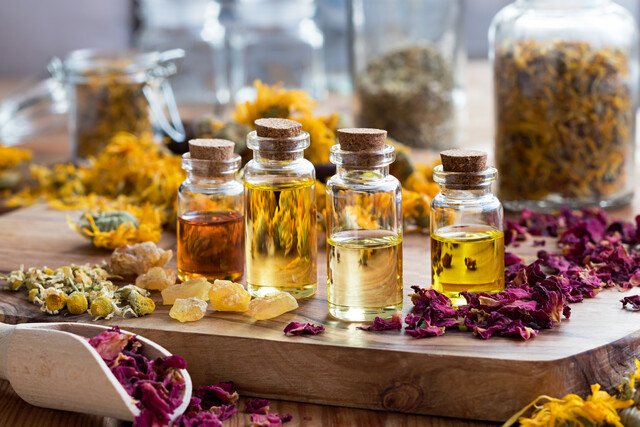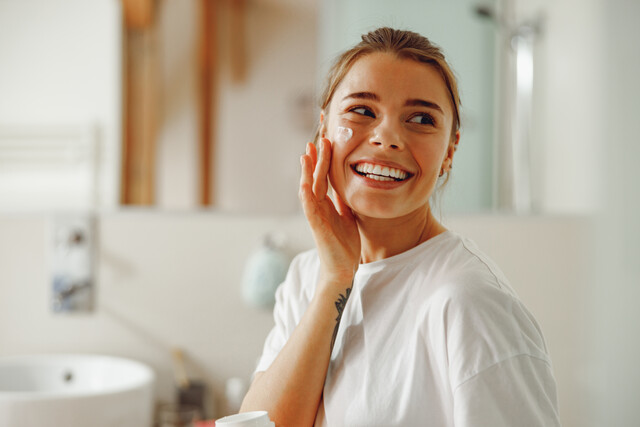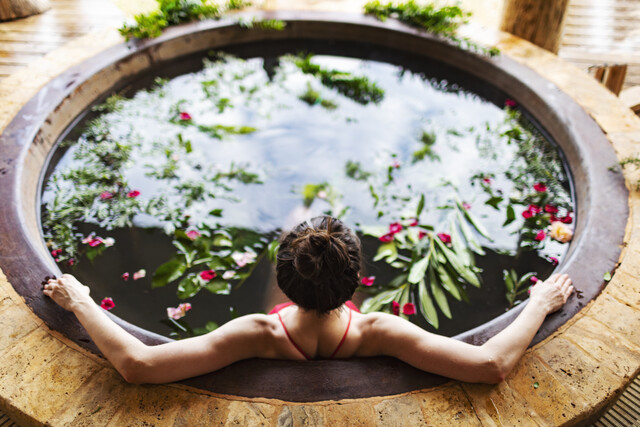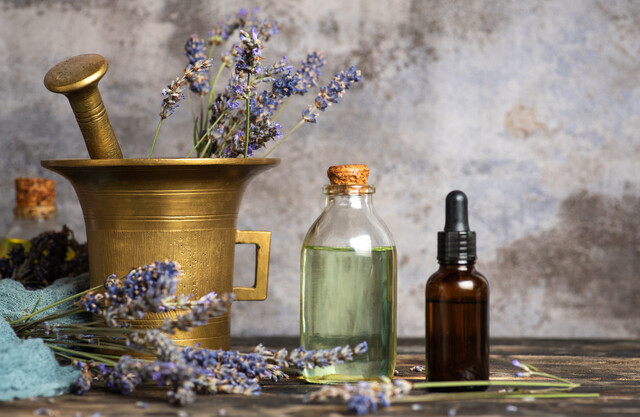Objectives
In this article, you will learn how and why the skin ages and common problems that occur as this happens. Also, you will learn how to combat and minimize the effect of time and the elements on your skin to maintain the healthiest skin possible throughout your senior years.
Fighting Wrinkles and Maintaining Collagen and Elastin production
As the skin ages, production of collagen (provides strength and flexibility) and elastin (gives skin its tone) decreases significantly. Although this begins in your 20s, it is largely unnoticeable until much later in life when the process accelerates. When collagen and elastin production is inhibited, the following can occur:
-
Fine lines and wrinkles
-
Thin and dry skin
-
Hollow cheeks and sunken eyes
-
Sagging neck
-
Abnormal hair growth
Although it is inevitable for collagen and elastin production to slow, there are ways to decelerate the process.
-
Consume a lot of Vitamin C, which promotes collagen production. The best sources are fruits such as oranges, pineapples, squash, green peppers and broccoli.
-
Staying away from cigarette smoke helps maintain the skins elasticity.
-
Eating antioxidant-rich foods, such as blueberries, cranberries, and dark leafy greens helps to fight free radicals that damage the skin.
-
Exercise regularly, which not only increases blood flow, but also collagen production and skin thickness.
External Wrinkle Reducers
In addition to eating healthily and exercising, nourishing your skin from the outside can also help maintain elasticity. The cosmetic aisles are bursting with so called "miracle anti-aging creams", but most do little to justify the exorbitant price tag. Also, look at the women in other cultures, many of them have beautiful, glowing skin and they have never set foot in a department store. This is because they harness the youthful benefits of natural plants and oils that grow in their regions to moisturize their skin and provide it with essential nutrients for health.
Some of the most effective cultural moisturizers are:
Coconut oil is used by women in the Polynesian and Pacific islands and has been used for hundreds of years as a skin salve and moisturizer, to great acclaim. Coconut oil contains fatty acids essential to healthy skin, as well as Vitamins K and E. Coconut oil helps smooth and plump the skin and staves off the development of wrinkles and sagging skin.
The ingredients in coconut oil are also beneficial for those with severe breakouts, as it is antibacterial and kills many strains of fungus, bacteria, and viruses. Coconut oil is also deeply moisturizing and healing and has been used to reduce the symptoms of eczema, psoriasis, and other skin conditions.
Olive oil hails from the Mediterranean and is the beauty secret of Italian and Spanish women. You may be more familiar with olive oil for cooking, but it has great benefits for the skin as well. Used by the ancient Egyptians and Greeks, olive oil is packed with oleic acid and Vitamin E, which helps to provide elasticity and soften skin.
Olive oil can be used straight on the skin and hair as a moisturizer or added to other oils to enhance the texture and smell. You can also mix sugar crystals with olive oil for a quick and effective body scrub.
Argan oil is considered liquid gold in Morocco and is procured from the pit found in the fruit of the argan tree. Used by the indigenous Berbers for centuries, this oil is touted as a youth elixir. Using argan oil on your face greatly reduces the formation of fine lines and wrinkles. Due to the high fatty acid and vitamin content, the oil also helps to soften and erase existing wrinkles for a smooth, glowing complexion.
Food for Thought
Were you aware that there is natural sunscreen available? Also, in the past, have you bought expensive anti-aging creams or serums? Did you find them to be effective? Which of the traditional cultural anti-aging oils are you intrigued to try?
Conclusion
Natural Skin Care for Compromised Skin
Section 1. The Affects of Chemotherapy and Radiation Treatment on the Skin
Chemotherapy can be an arduous experience. The drugs used in chemotherapy attack rapidly dividing and regenerating cells, regardless if they are healthy or not. Skin cells constantly regenerate, which makes the skin prime for attack from chemotherapy and radiation treatment.
The side affects of chemotherapy can be harsh, but usually only last during treatment and soon thereafter. However, if you are enduring multiple rounds of radiation, the side affects can be not only uncomfortable, but extremely debilitating.
Some of the common results of ongoing chemotherapy include:
-
Dry, cracked skin
-
Acneiform rash on the face
-
Red, painful palms and soles or a rash on the hands and feet (Hand/Foot Syndrome)
-
Skin blisters
-
Hair loss and scalp tenderness
-
Extreme sensitivity to sunlight and a tendency to burn easily
-
Clusters of pimple like bumps on the face and torso
-
Increased dead skin cells, which blacken and peel
-
Hyper-pigmentation
-
Thinning, darkening, or separation of nails from the finger
Many people undergoing chemotherapy find that their skin is extremely sensitive and irritated, even to the point that wearing clothing can be extremely uncomfortable. It
Is important to be aware of any item or product that exacerbates the situation and leads to further irritation and discomfort.
Section 2. How Synthetic Products Damage Compromised Skin
Because the skin is already highly sensitive and oftentimes cracked, synthetic skin care products are especially harmful to those undergoing radiation and chemotherapy. This is because the chemicals seep deeper into the skin more easily and work to inflame already damaged skin. Even if the skin is not cracked or blistered, the affects of the chemical compounds mixing with the cancer drugs can cause extreme redness, irritation, and burning.
In addition to worsening the state of already compromised skin, using chemical-based personal care products increases the likelihood of the cancer persisting or reoccurring. This is due to the fact that many commercial skin care products contain harmful elements that actually promote cancer growth and proliferation.
Below are some especially harmful ingredients to avoid:
Aluminum is a staple ingredient in most deodorants which is highly toxic. However, it is used because it has the ability to absorb odors and has disinfectant qualities. The problem is that aluminum, when applied through deodorant is absorbed and stored in the lymphatic tissue under the arms and near the breast. In fact, studies have shown a high accumulation of aluminum in breast cancer patients. There are natural deodorants available without aluminum that can be purchased at Whole Foods, Trader Joes and most health food stores.
Synthetic sunscreens contain the harmful chemicals oxybenzone, benzophenone-3, and octyl methoxycinnamate, which can penetrate the skin and disrupt cell growth and reproduction. Sunscreen that contains zinc oxide (a natural mineral that reflects sunlight) is a much safer option. As much as commercial sunscreens tout the promise that they "may" help prevent skin cancer, they in fact contain many known chemicals and carcinogens that bring about the very thing they claim to alleviate.
Mineral and Petroleum oil,known as petrochemicals are the byproducts of crude oil. These ingredients are added to more than 90 percent of commercial skin care products, which claim to soften and moisturize skin. Products such as Vaseline and baby oil are almost 100 percent made up of these ingredients.
Contrary to popular belief, these products do nothing to moisturize the skin. They create a shiny, slick coating which gives the appearance of moisture, but is anything but. Mineral oil and petroleum products actually create a barrier on the skin, through which real moisture cannot penetrate. These oils clog pores and lead to acne and blackheads. Products that are made from mineral oil can also containpolycyclic aromatic hydrocarbons (PAHS), which can cause cancer.
Artificial Dye is made from processed coal tar and is extremely disruptive to the human body. Manufactured dye has been known to cause behavior problems in children, as well as allergies and they are also known to promote cancer growth. However, they are used in most commercial products to create visually appealing creams and lotions.
Section 3. Safe Natural Ingredients and Products to Sooth and Heal
Undergoing a diagnosis and subsequent treatment for cancer is harsh enough. Taking the time to learn about safe and non-irritating personal care products to use during treatment can help make the process more bearable.
Below is a list of specific brands and products that are formulated to be safe for compromised skin:
CV Skinlabs is a new line of skincare specifically developed for cancer patients, burn victims, and anyone dealing with very sensitive or compromised skin. The line was launched by a cancer survivor who lost her own father to the ravages of cancer as well. The brand promises to be safe for any skin type and does not contain any artificial colors, scents, or other harmful ingredients that can cause or aggravate cancer.
Alra Care Products has a line that includes natural lotion, shampoo, and deodorant. The company has been formulating skin care products for cancer patients for 20 years and is recommended by doctors and hospitals. The lotion is formulated to be extremely gentle and moisturizing on radiation-treated skin. The shampoo is specially formulated for those suffering from hair loss and alopecia. In addition, the non-toxic deodorant is devoid of toxic aluminum found in most commercial brands.
All Natural Creations provides a light shea butter-based lotion and a heavier salve that is beneficial for chemotherapy and radiation patients. Both products are free of harmful preservatives (parabens), synthetic fragrances, and drying alcohols.
Food for Thought
Have you or anyone you know ever been affected by Cancer? Did they struggle with skin care issues? How might knowledge of natural skin care products have improved their recovery?
Conclusion
Making Your Own Natural Skin Care Products
Objectives
In this section, you will learn how easy and rewarding it is to make your own skin care and spa products. You will learn about the necessary ingredients for various products, tools that will make the job easier.
Section 1. Getting Started -The Tools of the Trade
What to Make?
Making your own skin care products is fun and exciting. As you learn, it's best to start out with simple recipes. However, as you gain experience and become more adventurous, you are only limited by your own creativity. To begin, the easiest items to make include body scrub, body and hair oils, and facial masks. More advanced items include body butters, lip balm, and lotions. Many people find making their own skin care products so rewarding, they stop buying commercial products altogether!
Purchasing the Right Tools
There are a few items that are important to have on hand when making your own products. Although most homemade skin care products are mixed up in the kitchen, it is important to have separate tools for making your products to avoid cross contamination.
Depending on the amount and type of products you will be making, you should consider purchasing the following:
-
Glass mixing bowls of various sizes
-
Double-boiler to melt waxes and butters (can also use a glass bowl or Pyrex measuring cup in a pot of boiling water)
-
Electric hand mixer to mix lotions, lip balm, and body butter
-
Measuring spoons and cups
-
Mixing spoons, plastic spatulas, and syringes
-
Vegetable grater and sharp knives for cutting and grating wax and other solid materials
-
Bottles and jars with lids to hold your creations
-
Dark glass bottles to store oil mixtures (preserves them longer)
-
Plastic tablecloth to protect your work surface
-
Apron and gloves
It is recommended to purchase a large plastic bin or tote with a lid to store your supplies so that they stay clean and unbroken. However, it's important to wash all of your items thoroughly before using them to avoid transferring bacteria to your mixtures. If you are just starting out, purchase a few items to make your first few items, them branch out.
Section 2. Sourcing Ingredients
As we have learned, the quality of the ingredients is so important to the outcome and efficacy of the final product. Below are some tips for purchasing the best ingredients:
-
For the best results, skin care oils should be virgin, and the extraction method should be cold- or expeller-pressed.
-
Butters are best if organic and have not been deodorized. For example, cocoa butter has a very heady scent that eliminates the need for additional scent.
-
Items like sugar and salts for scrubs should be as pure and unrefined as possible. For example, Himalayan sea salt is much better and nourishing than table salt.
-
The best thickener for lip balms and body butters is natural beeswax, which has a lovely honey scent.
-
Essential oils are the concentrated oils of plants that will give your creations their scent and also provide healing benefits to the skin.
If you just want to experiment with making one or two items for now, you can purchase butters and oils at a health food store, and some of the other supplies at a kitchen or craft store. However, if you want to experiment with a wide range of concoctions, or are looking to sell your creations, purchasing supplies in bulk or wholesale quantities will save you time and money.
Below are some of the most trusted suppliers of natural skin care ingredients and cosmetic supplies online:
Mountain Rose Herbs is one of the largest and most trusted sources of bulk supplies for making skin care products. They sell everything from raw shea and cocoa butter, to essential and vegetable oils, herbs and teas. They provide an excellent product range and include certified organic versions of many of their products.
Bottles and Jars is a family owned company that provides affordable bottles and jars in a range of styles and functionality. The owners are very personable and love to work with individual crafters or small businesses.
Essential Wholesale Sellers of bulk ingredients, including lotion bases, facial masks, and essential oils. The company offers natural and organic products, as well as private label services.
Wellington Fragrance This company offers essential oils and flavor oils, as well as reed diffusers, supplies for candle making, massage oils, and sea salts.
Section 3. Skin Care Recipes
Now the fun part -- browsing tantalizing skin care recipes that you can make in your own home! There are a plethora of recipes available for you to experiment with. Also, because natural ingredients don't contain volatile chemicals, they are very versatile and you can customize pretty much any recipe to your needs without worrying about adverse reactions.
Below are links to recipes that you may want to consider making. Take your time and choose something that sounds fun and easy, or that addresses a skin concern that you have. For now, select the recipe and make sure that you have the necessary tools and ingredients on hand.
Food for Thought
Are you excited at the prospect of making your own skin care products? Have you ever done anything like this before? What might your first project be, and where will you get your ingredients and tools?
Conclusion:



























